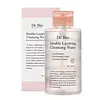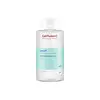What's inside
What's inside
 Key Ingredients
Key Ingredients

 Benefits
Benefits

 Concerns
Concerns

 Ingredients Side-by-side
Ingredients Side-by-side

Water
Skin ConditioningIsododecane
EmollientIsopropyl Palmitate
EmollientDipropylene Glycol
HumectantCetyl Ethylhexanoate
Emollient1,2-Hexanediol
Skin ConditioningHydrogenated Poly(C6-14 Olefin)
EmollientSodium Chloride
MaskingHydroxyacetophenone
AntioxidantSodium Citrate
BufferingDisodium EDTA
Centella Asiatica Extract
CleansingEpilobium Angustifolium Flower/Leaf/Stem Extract
Skin ConditioningSaponaria Officinalis Leaf Extract
AntimicrobialSapindus Trifoliatus Fruit Extract
Skin ConditioningHydrolyzed Gardenia Florida Extract
Antioxidant4-Terpineol
MaskingHibiscus Sabdariffa Flower Extract
Skin ConditioningNelumbium Speciosum Flower Extract
Skin ConditioningNymphaea Alba Flower Extract
Skin ConditioningPrunus Serrulata Flower Extract
Skin ConditioningMaltodextrin
AbsorbentButylene Glycol
HumectantLactobacillus Ferment Lysate
Skin ConditioningBiosaccharide Gum-4
Skin ConditioningXanthan Gum
EmulsifyingEthylhexylglycerin
Skin ConditioningCeramide NP
Skin ConditioningAsiaticoside
AntioxidantMadecassoside
AntioxidantAsiatic Acid
Skin ConditioningMadecassic Acid
Skin ConditioningWater, Isododecane, Isopropyl Palmitate, Dipropylene Glycol, Cetyl Ethylhexanoate, 1,2-Hexanediol, Hydrogenated Poly(C6-14 Olefin), Sodium Chloride, Hydroxyacetophenone, Sodium Citrate, Disodium EDTA, Centella Asiatica Extract, Epilobium Angustifolium Flower/Leaf/Stem Extract, Saponaria Officinalis Leaf Extract, Sapindus Trifoliatus Fruit Extract, Hydrolyzed Gardenia Florida Extract, 4-Terpineol, Hibiscus Sabdariffa Flower Extract, Nelumbium Speciosum Flower Extract, Nymphaea Alba Flower Extract, Prunus Serrulata Flower Extract, Maltodextrin, Butylene Glycol, Lactobacillus Ferment Lysate, Biosaccharide Gum-4, Xanthan Gum, Ethylhexylglycerin, Ceramide NP, Asiaticoside, Madecassoside, Asiatic Acid, Madecassic Acid
Water
Skin ConditioningDipropylene Glycol
HumectantPolyglyceryl-4 Caprate
EmulsifyingMelissa Officinalis Leaf Extract
Skin ConditioningSaponaria Officinalis Leaf Extract
AntimicrobialTrehalose
HumectantPanthenol
Skin Conditioning1,2-Hexanediol
Skin ConditioningCitric Acid
BufferingRosmarinic Acid
AntioxidantSodium Cocoamphoacetate
CleansingCaprylyl Glycol
EmollientEthylhexylglycerin
Skin ConditioningSodium Citrate
BufferingLauryl Glucoside
CleansingGlycerin
HumectantSodium Cocoyl Glutamate
CleansingSodium Lauryl Glucose Carboxylate
CleansingDisodium EDTA
Gluconolactone
Skin ConditioningButylene Glycol
HumectantWater, Dipropylene Glycol, Polyglyceryl-4 Caprate, Melissa Officinalis Leaf Extract, Saponaria Officinalis Leaf Extract, Trehalose, Panthenol, 1,2-Hexanediol, Citric Acid, Rosmarinic Acid, Sodium Cocoamphoacetate, Caprylyl Glycol, Ethylhexylglycerin, Sodium Citrate, Lauryl Glucoside, Glycerin, Sodium Cocoyl Glutamate, Sodium Lauryl Glucose Carboxylate, Disodium EDTA, Gluconolactone, Butylene Glycol
 Reviews
Reviews

Ingredients Explained
These ingredients are found in both products.
Ingredients higher up in an ingredient list are typically present in a larger amount.
1,2-Hexanediol is a synthetic liquid and another multi-functional powerhouse.
It is a:
- Humectant, drawing moisture into the skin
- Emollient, helping to soften skin
- Solvent, dispersing and stabilizing formulas
- Preservative booster, enhancing the antimicrobial activity of other preservatives
Butylene Glycol (or BG) is used within cosmetic products for a few different reasons:
Overall, Butylene Glycol is a safe and well-rounded ingredient that works well with other ingredients.
Though this ingredient works well with most skin types, some people with sensitive skin may experience a reaction such as allergic rashes, closed comedones, or itchiness.
Learn more about Butylene GlycolDipropylene Glycol is a synthetically created humectant, stabilizer, and solvent.
This ingredient helps:
Dipropylene glycol is technically an alcohol, but it belongs to the glycol family (often considered part of the ‘good’ alcohols). This means it is hydrating and gentle on skin unlike drying solvent alcohols like denatured alcohol.
As a masking agent, Dipropylene Glycol can be used to cover the smell of other ingredients. However, it does not have a scent.
Studies show Dipropylene Glycol is considered safe to use in skincare.
Learn more about Dipropylene GlycolDisodium EDTA plays a role in making products more stable by aiding other preservatives.
It is a chelating agent, meaning it neutralizes metal ions that may be found in a product.
Disodium EDTA is a salt of edetic acid and is found to be safe in cosmetic ingredients.
Learn more about Disodium EDTAEthylhexylglycerin (we can't pronounce this either) is commonly used as a preservative and skin softener. It is derived from glyceryl.
You might see Ethylhexylglycerin often paired with other preservatives such as phenoxyethanol. Ethylhexylglycerin has been found to increase the effectiveness of these other preservatives.
We don't have a description for Saponaria Officinalis Leaf Extract yet.
Sodium Citrate is the sodium salts of citric acid. In skincare, it is used to alter pH levels and acts as a preservative.
Its main functions are to maintain the pH of a product and neutralize metal ions.
The acidity of our skin is maintained by our glands and skin biome; normal pH level of skin is slightly acidic (~4.75-5.5).
Being slightly acidic allows our skin to create an "acid mantle". This acid mantle is a thin barrier that protects our skin from bacteria and contaminants.
Learn more about Sodium CitrateWater. It's the most common cosmetic ingredient of all. You'll usually see it at the top of ingredient lists, meaning that it makes up the largest part of the product.
So why is it so popular? Water most often acts as a solvent - this means that it helps dissolve other ingredients into the formulation.
You'll also recognize water as that liquid we all need to stay alive. If you see this, drink a glass of water. Stay hydrated!
Learn more about Water